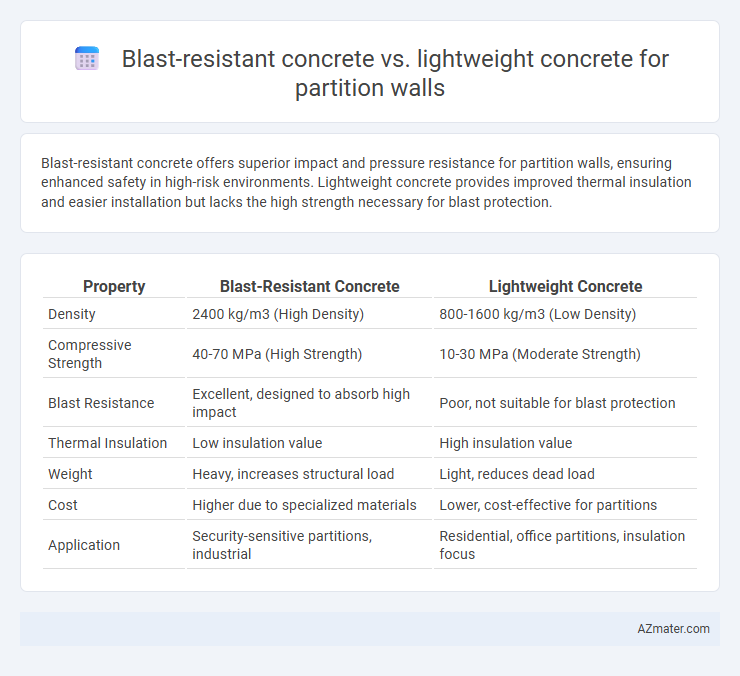Blast-resistant concrete offers superior impact and pressure resistance for partition walls, ensuring enhanced safety in high-risk environments. Lightweight concrete provides improved thermal insulation and easier installation but lacks the high strength necessary for blast protection.
Table of Comparison
| Property | Blast-Resistant Concrete | Lightweight Concrete |
|---|---|---|
| Density | 2400 kg/m3 (High Density) | 800-1600 kg/m3 (Low Density) |
| Compressive Strength | 40-70 MPa (High Strength) | 10-30 MPa (Moderate Strength) |
| Blast Resistance | Excellent, designed to absorb high impact | Poor, not suitable for blast protection |
| Thermal Insulation | Low insulation value | High insulation value |
| Weight | Heavy, increases structural load | Light, reduces dead load |
| Cost | Higher due to specialized materials | Lower, cost-effective for partitions |
| Application | Security-sensitive partitions, industrial | Residential, office partitions, insulation focus |
Introduction to Partition Wall Materials
Partition wall materials vary significantly in their properties and applications, with blast-resistant concrete offering superior strength and impact resistance ideal for high-security environments. Lightweight concrete, characterized by reduced density and thermal insulation benefits, is preferred for non-load-bearing partitions where ease of installation and energy efficiency are priorities. Selecting the appropriate material depends on factors such as structural requirements, safety standards, and thermal performance needs.
Overview of Blast-Resistant Concrete
Blast-resistant concrete is engineered to withstand high-pressure explosions by incorporating high-strength aggregates, specialized admixtures, and fiber reinforcement to enhance its toughness and energy absorption capabilities. This type of concrete typically exhibits increased density and compressive strength compared to lightweight concrete, which improves its ability to resist fragmentation and spalling during blast events. Its application in partition walls provides critical protection in high-risk environments, balancing structural integrity with safety requirements.
Properties of Lightweight Concrete
Lightweight concrete offers reduced density, typically ranging from 800 to 1,600 kg/m3, making it ideal for partition walls where weight reduction is crucial. It provides good thermal insulation and fire resistance due to its porous structure, enhancing building energy efficiency and safety. Although its compressive strength is generally lower than blast-resistant concrete, lightweight concrete ensures sufficient durability for non-load-bearing partitions.
Structural Performance Comparison
Blast-resistant concrete exhibits significantly higher compressive strength and energy absorption capacity, making it ideal for partition walls requiring enhanced structural integrity against explosive loads. Lightweight concrete, characterized by lower density and thermal insulation properties, offers reduced dead load but typically falls short in withstanding high-impact forces compared to blast-resistant alternatives. Structural performance tests reveal that blast-resistant concrete partitions maintain stability and minimize fragmentation under blast effects, whereas lightweight concrete partitions prioritize weight savings at the expense of blast resilience.
Fire Resistance Capabilities
Blast-resistant concrete exhibits exceptional fire resistance, maintaining structural integrity at temperatures exceeding 1,000degC due to its dense composition and specialized additives that reduce spalling. Lightweight concrete, while advantageous for reducing wall weight, typically contains air-entrained aggregates that can compromise fire resistance by allowing higher heat penetration and faster degradation under intense fire exposure. For partition walls in high-risk fire scenarios, blast-resistant concrete offers superior protection by combining thermal insulation with mechanical strength, ensuring safety and durability.
Acoustic Insulation Differences
Blast-resistant concrete offers superior acoustic insulation due to its dense composition, effectively dampening sound transmission compared to lightweight concrete. Lightweight concrete, though easier to handle and install, generally provides lower sound insulation because of its porous structure, which allows more noise penetration. Soundproofing performance in partition walls is significantly enhanced by the mass and density of blast-resistant concrete, making it preferable for environments needing high acoustic insulation.
Installation and Construction Costs
Blast-resistant concrete for partition walls demands specialized materials and skilled labor, resulting in higher installation and construction costs due to its enhanced durability and safety features. Lightweight concrete offers reduced overall project expenses through easier handling, faster installation, and lower structural support requirements. Choosing between these materials depends on prioritizing safety needs against budget constraints in partition wall construction.
Durability and Maintenance
Blast-resistant concrete demonstrates superior durability compared to lightweight concrete due to its higher density and enhanced impact absorption capabilities, making it ideal for partition walls in high-risk environments. Maintenance requirements for blast-resistant concrete are generally lower since it resists cracking and surface damage under extreme conditions, unlike lightweight concrete which may require more frequent repairs due to its porous structure. Lightweight concrete offers benefits in ease of installation and thermal insulation but necessitates more vigilant upkeep to prevent deterioration over time.
Environmental Impact and Sustainability
Blast-resistant concrete for partition walls offers high durability and enhanced safety but involves higher embodied energy and carbon emissions due to cement content and dense aggregates. Lightweight concrete reduces structural load and energy consumption during transportation and installation, contributing to lower overall environmental impact and improved sustainability through the use of recycled materials and reduced resource demand. Choosing lightweight concrete can significantly decrease a building's carbon footprint while maintaining adequate strength for non-structural partition walls.
Application Suitability for Building Types
Blast-resistant concrete is ideal for high-security buildings such as military facilities, government offices, and critical infrastructure due to its superior ability to absorb and dissipate explosive forces. Lightweight concrete is more suitable for residential and commercial partition walls where reduced load and improved thermal insulation are priorities, enhancing energy efficiency and ease of installation. Choosing between these materials depends on balancing structural safety requirements with budget and building function.

Infographic: Blast-resistant concrete vs Lightweight concrete for Partition wall
 azmater.com
azmater.com